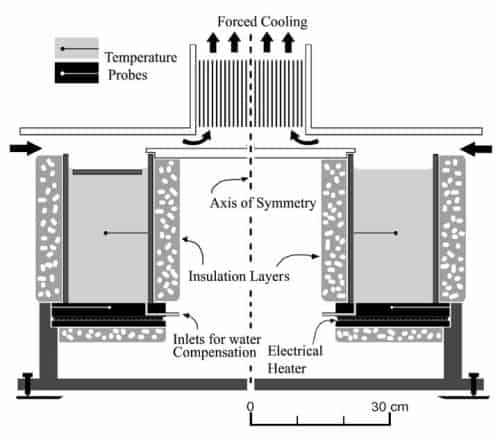
Physicists in the US have performed a simple table-top experiment that could provide new insight into why the Earth’s continents drift apart and then move back together over several hundred-million years.
Jun Zhang and Bin Liu of New York University tracked the motion of a handful of millimetre-sized balls at the bottom of a heated tank containing a mixture of water and glycerol. They found that convection currents in the tank caused the balls to pack together tightly in a clump — before drifting apart to form another clump on the opposite side of the tank.
According to Zhang, this is the first experiment that studies how convection currents interact with a collection of solid objects — a process that is thought to drive continental drift.
Supercontinent breaks up
About 200m years ago most of the Earth’s landmass existed in the form of a “supercontinent” called Pangaea, which has since broken up into the seven continents that we know today. This process, however, appears to be cyclical and Pangaea was probably formed when the remnants of an earlier supercontinent were drawn together.
Many geophysicists believe that this cyclical pattern could be related to regular disruptions in the convection currents in the Earth’s mantle, upon which the continents float.
However, scientists have had little practical understanding of how the presence of solid objects affects convection. Now, Jun Zhang and Bin Liu have done a simple table-top experiment that reveals that the presence of solid objects can have a significant effect on convection (Phys Rev Lett 100 244501).
The physicists filled a 3-litre rectangular tank with a mixture of glycerol and water. The liquid is heated from below by a hot plate and heat is removed at the top of the tank by a water-cooled plate. The sides of the tank are transparent and a video camera is used to study the motion of the fluid.
In the absence of any solid objects, the tank becomes one large convection cell, with the fluid rotating in one sense (clockwise or anti-clockwise) for many hours. Occasionally, however, the rotation will reverse in a spontaneous process that is believed to be related to the rare occasion when random fluctuations in the flow are sufficient to overcome the energy barrier between clockwise or anti-clockwise convection.
400 nylon spheres
Zhang and Liu then placed about 400 nylon spheres (with a diameter of 3.2 mm) into the tank. The spheres are denser than the fluid and therefore sink — covering about half the area of the bottom of the tank. The balls can roll around the bottom of the tank, and their presence had an immediate effect on the convection process, which switches direction every hour or so — rather than enduring for many hours.
The video camera revealed that the balls create a set of patterns on the bottom of the tank that changed along with the convective flow. As the liquid moved in one direction along the bottom of tank, it jammed the balls together at one end of the rectangular bottom of the tank. When about one half of the tank bottom was completely covered in close-backed balls, the convective current began to weaken and eventually reverse — sending the balls to the opposite end of the tank.
According to Zhang, the reversals occur because the carpet of close-packed spheres acts as an insulator that reduces the amount of heat flowing upward at one end of the tank. Meanwhile at the other end of the tank — where fluid had been flowing downward — the absence of balls means that heat can flow freely up from the bottom, disrupting the downward flow. The overall effect is a reversal in the rotation of the cell.
While a few hundred balls rolling around the bottom of a small tank may seem to have little to do with continental drift, Zhang says that the systems are similar. This is because the crust under a continent is much thicker than the crust under the oceans, causing heat to become trapped under continents. This could disrupt convective flow in the same way as the insulating carpet of balls.
”You may regard those spheres as small (micro) continents and the convective fluid as the mantle of the Earth”, he explained. ”Our finding implies that supercontinents like Pangaea can be periodically created and also periodically broken apart”.
Zhang told physicsworld.com that the team are now working on a system that is more ‘Earth-like’. In particular, the fluid and balls are not restricted by walls in a rectangular tank. Instead, they are in a tank with vertical walls that are concentric cylinders.




